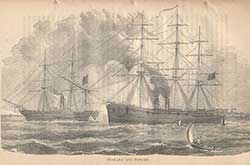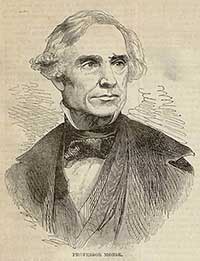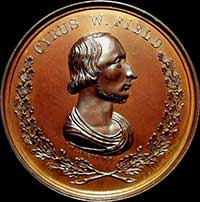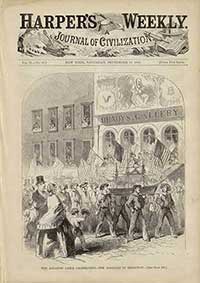
Displaced Representation and Nationalistic
Appropriation: Illustrating the Atlantic
Cable of 1858
- Mark Niemeyer
_______________________________

Fig. 33. Laying the Cable in Mid Ocean, 1858 

Fig. 34. Niagara and Tender, 1858 

Fig. 36. Samuel F. B. Morse, 1858 

Fig. 38. G. H. Lovett, Cyrus W. Field
Medal, 1858 

One sub-group of illustrations that can be seen in this context are those emphasizing the exploit as a heroic drama, carried out, they often more or less subtly seem to suggest, primarily, or most importantly, by daring Americans. An illustration in Harper’s Weekly of the two ships that laid the cable, starting off in opposite directions, just after having spliced together the two halves of the cable in the middle of Atlantic, could be interpreted as another representation of the Anglo-American cooperation that made the completion of the project possible (fig. 33). But the American ship, the Niagara—even if part of it is cut off by the right-hand margin of the image—looms larger than the British Agamemnon, which appears not only smaller, but is also heading away from the viewer. And, most significantly for this discussion, the American flag is seen flying prominently above the stern of the Niagara, while the flag on the British ship is much smaller and its details barely discernible. Finally, while men engaged in various activities, including the paying out of the cable itself, are clearly visible on the deck of the American ship, the Agamemnon is so small that no members of its crew can be seen. The same illustration appears in Mullaly’s book as well (indicating a certain circulation of at least some of the images), and his work also includes another image of the Niagara, accompanied by its tender, with no British ships in sight, and with both of the American ships flying flags, the Niagara, the regular national flag of the United States, and the tender, the U.S. Navy jack (an ensign with white stars on a dark [blue in actuality] field) (fig. 34).
The landing of the cable on the western shore of the Atlantic Ocean was also sometimes presented as a heroic act with nationalistic overtones. An illustration in Frank Leslie’s Illustrated Newspaper, for example, shows the crew of the Niagara erecting a liberty pole at Bull’s Arm Bay (or Bull Arm Bay), a part, in fact, of the larger Trinity Bay in Newfoundland (fig. 35  ). While the nationalism is, perhaps, not overly obvious here, there is, in fact, something rather aggressive about the American crew of a United States naval vessel putting up a liberty pole, one of the key symbols of the American Revolution, in which the United States gained its independence from Great Britain, on the shores of what was, of course, still British territory. No American flag appears in the image, but none is necessary. The illustration, in fact, portrays what looks like a taking possession of a foreign land by Americans or perhaps an implicit incitement of the Canadians to rise up themselves and claim their own liberty, also in the form of independence from Great Britain. It could also be noted that the liberty pole, somewhat like the telegraph pole discussed earlier, also suggests a cross, thus adding a subtle religious layer to the nationalistic dimension.
). While the nationalism is, perhaps, not overly obvious here, there is, in fact, something rather aggressive about the American crew of a United States naval vessel putting up a liberty pole, one of the key symbols of the American Revolution, in which the United States gained its independence from Great Britain, on the shores of what was, of course, still British territory. No American flag appears in the image, but none is necessary. The illustration, in fact, portrays what looks like a taking possession of a foreign land by Americans or perhaps an implicit incitement of the Canadians to rise up themselves and claim their own liberty, also in the form of independence from Great Britain. It could also be noted that the liberty pole, somewhat like the telegraph pole discussed earlier, also suggests a cross, thus adding a subtle religious layer to the nationalistic dimension.
Another group of illustrations related to the Atlantic Cable that can be seen as implicitly, and sometimes overtly, nationalistic is represented by the many portraits of the principal actors in the “heroic” drama. This collection of “great men” made up a sort of Atlantic Cable pantheon of eminent Victorians, who very frequently just happened to be American. The figures include, for example, Samuel F. B. Morse, the holder of the American patent on the telegraph, who was also one of Cyrus W. Field’s partners (fig. 36), and William L. Hudson, U.S. naval officer and captain of the Niagara (fig. 37  ). But the America who was singled out for the most praise was, not surprisingly, Cyrus W. Field himself, who was consistently, and justifiably, it must be said, presented as the leading force behind the project. His portrait, as already noted, appears on the frontispiece of Briggs and Maverick’s book (and he is, of course, depicted in Mullaly’s work as well), along with his distinctive signature, which became almost as famous as the image of the man himself. Another commemorative medal that was struck in honor of the completion of the Atlantic Cable features the bust of Field on the obverse (fig. 38). While a solid gold specimen was presented to Field himself, souvenir copies were also struck for sale to the general public. On the medal, Field appears like a Roman general or emperor, his head encircled by a laurel wreath, symbolic of victory. The reverse of the medal (fig. 39
). But the America who was singled out for the most praise was, not surprisingly, Cyrus W. Field himself, who was consistently, and justifiably, it must be said, presented as the leading force behind the project. His portrait, as already noted, appears on the frontispiece of Briggs and Maverick’s book (and he is, of course, depicted in Mullaly’s work as well), along with his distinctive signature, which became almost as famous as the image of the man himself. Another commemorative medal that was struck in honor of the completion of the Atlantic Cable features the bust of Field on the obverse (fig. 38). While a solid gold specimen was presented to Field himself, souvenir copies were also struck for sale to the general public. On the medal, Field appears like a Roman general or emperor, his head encircled by a laurel wreath, symbolic of victory. The reverse of the medal (fig. 39  ) includes an inscription in Latin around the outer edge, Nil Desperandum Perseverantia Vincit (“Never Despair – Perseverance Conquers”), thus reinforcing the comparison with a hero of Ancient Rome, and an inscription in English reading, “Presented to Cyrus W. Field, by a Few of His Friends in New York, for His Perseverance, in Superintending the Laying of the Atlantic Telegraph Cable. Aug. 5TH 1858.” A more overtly nationalistic depiction of Field appeared on the cover of the August 21, 1858 issue of Harper’s Weekly (fig. 40
) includes an inscription in Latin around the outer edge, Nil Desperandum Perseverantia Vincit (“Never Despair – Perseverance Conquers”), thus reinforcing the comparison with a hero of Ancient Rome, and an inscription in English reading, “Presented to Cyrus W. Field, by a Few of His Friends in New York, for His Perseverance, in Superintending the Laying of the Atlantic Telegraph Cable. Aug. 5TH 1858.” A more overtly nationalistic depiction of Field appeared on the cover of the August 21, 1858 issue of Harper’s Weekly (fig. 40  ). In this portrait, Field’s image is surrounded not by a laurel wreath, but by an elaborate frame draped with a piece of the Atlantic Cable. The cable itself thus seems to take on the heroic symbolism of the laurel wreath it replaces. Scattered along the bottom of the frame are various tools and instruments that symbolize human technological advancement, and in the center is an escutcheon emblazoned with the stars and stripes of the flag of the United States, making a clear statement that the great achievement of the Atlantic Cable is distinctively American.
). In this portrait, Field’s image is surrounded not by a laurel wreath, but by an elaborate frame draped with a piece of the Atlantic Cable. The cable itself thus seems to take on the heroic symbolism of the laurel wreath it replaces. Scattered along the bottom of the frame are various tools and instruments that symbolize human technological advancement, and in the center is an escutcheon emblazoned with the stars and stripes of the flag of the United States, making a clear statement that the great achievement of the Atlantic Cable is distinctively American.
Depictions of the celebrations commemorating the completion of the Atlantic Cable—which sometimes got a bit out of control, as when the cupola of the New York City Hall caught on fire during the fireworks display that were part of festivities held on August 18, 1858—also often include elements emphasizing Americanness. One strikingly nationalistic image, which appears in the September 11, 1858 issue of Harper’s Weekly shows the crew of the American ship Niagara (“The Niagaras”) parading in the streets of New York City carrying a replica of their vessel and, more importantly for this discussion, passing in front of a row of prominently displayed American flags (fig. 41). The importance of the power of images is indirectly highlighted in this particular illustration since the group is depicted as it passes in front of Mathew Brady’s photographic studio.


